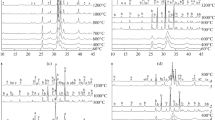Abstract
The Ca/P molar ratio, % CO 2−3 , and % HPO 2−4 was determined for a number of apatites prepared by the hydrolysis of amorphous calcium phosphate in the presence of solution carbonate. The Ca/P molar ratio for each apatite was significantly higher than for the corresponding amorphous precursor. The change in carbonate content was slight but the HPO 2−4 level in these apatites, as determined by the standard pyrolytic technique, was greatly reduced, sometimes to a near zero value. Infrared analysis, on the other hand, clearly showed an appreciable level of HPO 2−4 . Evidence obtained indicated that the carbonate interferes with the pyrolytic assay for HPO 2−4 by either blocking condensation to P2O 4−7 or by breaking down already formed P2O 4−7 . It is suggested that the pyrolytic method be used with great caution in assaying for HPO 2−4 in calcified tissue.
Résumé
Le rapport molaire Ca/P, % CO 2−3 et % HPO 2−4 sont déterminés pour un certain nombre d'apatites préparés par hydrolyse de phosphate de calcium amorphe en présence de solution de carbonate. Le rapport molaire Ca/P pour chaque apatite est significativement plus élevé que celui du précurseur amorphe correspondant. Le changement en contenu de carbonate est faible, mais la concentration en HPO 2−4 de ces apatites, déterminée selon la technique pyrolytique habituelle, est nettement réduite, et atteint souvent une valeur nulle. L'analyse infra-rouge montre, d'autre part, une concentration appréciable de HPO 2−4 . Il semble que le carbonate réagit au cours de la pyrolyse avec HPO 2−4 soit en bloquant une condensation de P2O 4−7 ou en dégradant du P2O 4−7 déjà formé. Il apparait qu'il faut utiliser la méthode de pyrolyse avec prudence pour déterminer la présence de HPO 2−4 dans les tissus calcifiés.
Zusammenfassung
Das molare Ca/P-Verhältnis sowie die prozentualen Anteile von CO 2−3 und HPO 2−4 wurden bei einer Anzahl von Apatiten bestimmt, welche durch Hydrolyse von amorphem Calciumphosphat, bei Anwesenheit von Karbonat in der Lösung, erhalten wurden. Das molare Ca/P-Verhältnis war bei jedem Apatit bedeutend höher als bei der entsprechenden amorphen Vorstufe. Das Karbonat veränderte sich wenig, jedoch war der HPO 2−4 -Gehalt dieser Apatite, mittels der pyrolytischen Standard-Technik bestimmt, stark reduziert und lag manchmal nahe beim Nullwert. Andererseits zeigte die Infrarot-Analyse eindeutig einen beträchtlichen HPO 2−4 -Gehalt. Somit wird bewiesen, daß Karbonat die pyrolytische Bestimmung von HPO 2−4 stört, entweder indem es die Kondensation zu P2O 4−7 blockiert oder schon gebildetes P2O 4−7 abbaut. Es wird vorgeschlagen, daß die pyrolytische Methode zur Bestimmung von HPO 2−4 in verkalktem Gewebe nur mit großer Vorsicht anzuwenden ist.
Similar content being viewed by others
References
Eanes, E. D., Posner, A. S.: Structure and chemistry of bone mineral. In: Biological calcification—cellular and molecular aspects, ed. H. Schraer, p. 1–26. New York: Appleton-Century-Crofts 1970
Fowler, B. O., Moreno, E. C., Brown, W. E.: Infrared spectra of hydroxyapatite, octacalcium phosphate and pyrolyzed octacalcium phosphate. Arch. oral Biol.11, 477–492 (1966)
Gee, A., Deitz, V. R.: Determination of phosphate by differential spectrophotometry. Analyt. Chem.25, 1320–1324 (1953)
Gee, A., Deitz, V. R.: Pyrophosphate formation upon ignition of precipitated basic calcium phosphates. J. Amer. chem. Soc.77, 2961–2965 (1955)
Greenfield, D. J., Eanes, E. D.: Formation chemistry of amorphous calcium phosphates prepared from carbonate containing solutions. Calcif. Tiss. Res.9, 152–162 (1972)
Hirschman, A., Sobel, A. E.: Composition of the mineral deposited duringin vitro calcification in relation to the fluid phase. Arch. Biochem. Biophys.110, 237–243 (1965)
Lewis, G. N.: Valence and the structure of atoms and molecules. New York: Chemical Catalog Co. 1923
Moeller, T.: Inorganic chemistry, chapter 9. New York: John Wiley & Sons, Inc. 1952
Pellegrino, E. D., Biltz, R. M.: Mineralization in the chick embryo. I. Monohydrogen phosphate and carbonate relationships during maturation of the bone crystal complex. Calcif. Tiss. Res.10, 128–135 (1972)
Quinaux, N.: Influence des composes alcalino-terreux sur la formation de groupes pyrophosphate par chauffage du phosphate tricalcique hydrate. Bull. Soc. Chim. biol. (Paris)46, 561–578 (1964)
Termine, J. D.: Mineral chemistry and skeletal biology. Clin. Orthop.85, 207–241 (1972)
Termine, J. D., Eanes, E. D.: Comparative chemistry of amorphous and apatitic calcium phosphate preparations. Calcif. Tiss. Res.10, 171–197 (1972)
Author information
Authors and Affiliations
Rights and permissions
About this article
Cite this article
Greenfield, D.J., Termine, J.D. & Eanes, E.D. A chemical study of apatites prepared by hydrolysis of amorphous calcium phosphates in carbonate-containing aqueous solutions. Calc. Tis Res. 14, 131–138 (1974). https://doi.org/10.1007/BF02060289
Received:
Accepted:
Issue Date:
DOI: https://doi.org/10.1007/BF02060289



